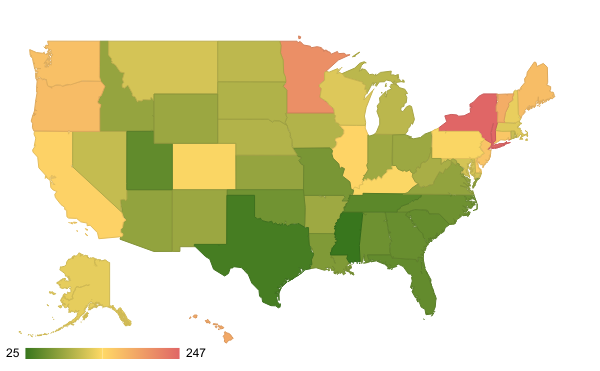2025 ACA Marketplace Plan Subsidy Chart and Calculator
Answer a few easy questions to calculate your subsidy eligibility in seconds.*
Updated on January 16th, 2025
How to Calculate
What Counts as Income
FAQ on Estimating Income
Eligibility Mistakes and Subsidy Repayment
How to Get Help Paying for Health Insurance
Your eligibility for ACA (Obamacare) plan subsidies this year depends on your income. If the cost of the “benchmark plan” (the second-lowest-cost silver plan) is more than a certain percentage of your income, up to 8.5%, you qualify for subsidies. These subsidies, or Premium Tax Credits (PTC) or Advance Premium Tax Credits (APTC), lower your monthly health insurance payments.
In 2025, your eligibility is based on your projected income and the benchmark plan cost. You qualify for subsidies if you pay more than 8.5% of your household income towards health insurance.
Next Steps: Check your eligibility using our ACA Subsidy Calculator, regardless of your income, to see your subsidy rate or consider switching plans.
Calculating Your 2025 Obamacare Subsidy
Subsidies are based on your income, the list price of the benchmark plan, and your required contribution toward health insurance. The actual subsidy differs between the benchmark plan and your expected contribution. You must estimate your income and compare it to the total plan premium before coverage starts.
2024 ACA Premiums by State: A Snapshot of Average Costs After Subsidies

This dataset from KFF shows the average ACA premium after subsidy for various U.S. states in 2024, with premiums ranging from as low as $25 in Mississippi to $247 in New York. Overall, the national average is $74, indicating significant regional variation in health insurance costs.
Eligibility
Who is eligible for the Premium Tax Credit?
- According to the IRS, you qualify if:
- Your household income meets specific requirements or you received unemployment benefits
- You do not file as “Married Filing Separately” (unless eligible due to domestic abuse or spousal abandonment).
- You are not claimed as a dependent.
- You:
- Enroll in Marketplace coverage (excluding catastrophic plans).
- Cannot access affordable employer coverage.
- Are not eligible for government programs like Medicaid, Medicare, or CHIP.
- Pay your share of premiums.
What happens if my income, family size, or other circumstances change during the year?
- If your income or family size differs from the Marketplace estimate, your Premium Tax Credit may be adjusted.
- Significant differences could result in a larger or smaller refund, or an additional balance due.
- Notify the Marketplace promptly about changes (e.g., income, marriage, divorce, birth, changes in coverage).
- Common changes that affect the credit:
- Income changes (e.g., lump sum Social Security payments, debt forgiveness).
- Marriage or divorce.
- Birth or adoption of a child.
- Changes in household composition or eligibility for other coverage.
How Can I See If I Qualify for Subsidies?
- You can easily calculate what sort of subsidies you might qualify for with our ACA subsidy calculator. See our calculator above.
- The calculator requires your ZIP code, household size, and income. (You may read this as annual household income, modified adjusted gross income, or yearly income – they’re all very similar.)
- Your subsidy is a single amount that applies across all plans, even though different plans will charge different monthly premiums.
- Once you input all your information, your premium subsidy, if any, will pop up.
- It is calculated automatically, and you don’t have to do anything further.
- When you sign up for a specific insurance plan, the subsidy will be sent monthly to your insurance company for the entire year, unless you drop the plan.
How Are Obamacare Subsidies Calculated?
The American Rescue Plan (ARP) of 2021 and the Inflation Reduction Act (IRA) of 2022 made ACA more affordable in two ways:
- Income Cap Removal: There is no longer a Federal Poverty Level (FPL) income cap. The benchmark Silver plan costs no more than 8.5% of your annual household income, regardless of income level. Before 2021, you were expected to spend between 2% and 9.83% of your income on health insurance. This range is now 0% to 8.5% until the end of 2025.
- Enhanced Subsidies for Unemployment: Since 2021, those receiving unemployment benefits can enroll in a low-cost, low-deductible health plan with enhanced federal subsidies. Additionally, the Biden administration fixed the “family glitch” in October 2022, allowing family members of people with employer plans to obtain subsidies.
How Much You Pay for a Benchmark Silver Plan
| Income (by federal poverty level) | % of Your Income |
| Less than 133% | 2.07% |
| At least 133% but less than 150% | 3.10% – 4.14% |
| At least 150% but less than 200% | 4.14% – 6.52% |
| At least 200% but less than 250% | 6.52% – 8.33% |
| At least 250% but less than 300% | 8.33% – 9.83% |
| At least 300% but not more than 400% | 9.83% |
| Over 400% | Not eligible |
Source: Internal Revenue Service. 26 CFR 601.105. irs.gov. Accessed September 2023.
Households with more than 8 people should add $5,140 per person.
What About Medicaid Instead of Subsidies?
In most states, those who make up to 138% of the federal poverty level qualify for Medicaid eligibility instead of ACA exchange subsidies.
In 2023, for a single person, 138% of the poverty level equates to $14,580; for a family of four, that amount equals $30,000.
Alaska and Hawaii are unique states with higher income guidelines – those can be found here.
What Are These Subsidies For?
This information applies to health insurance plans that cover you and your family during 2024.
ACA subsidies are available to reduce your monthly payments or as a credit for next year’s tax filing with the IRS.
New federal poverty level income levels are released annually in January. Those numbers are used immediately to determine eligibility for Medicaid and the Children’s Health Insurance Program (CHIP). They are also used in November when the ACA Open Enrollment Period begins.
What Counts As Income?
The right income to submit is your modified adjusted gross income or MAGI (basically, the annual income you report on your tax return, with a few tweaks).
Income To Include In Your Estimate
When applying for Marketplace coverage, estimate your household income for the upcoming year, not last year’s. You’ll provide both your current monthly and yearly income. The Marketplace uses “modified adjusted gross income (MAGI)” to determine eligibility for savings.
A household typically includes:
- The tax filer
- Their spouse (if applicable)
- Their tax dependents, even if they don’t need coverage
Types of Income To Count In Your Estimate
| Count these income types: | Don’t count these income types: |
| Alimony from divorces and separations finalized before January 1, 2019 | Alimony for divorces and separations finalized on or after January 1, 2019 |
| Capital gains | Child support |
| Excluded (untaxed) foreign income | Child Tax Credit checks or deposits (from the IRS) |
| Federal taxable wages (from your job) | Gifts |
| Investment income | Proceeds from loans (like student loans, home equity loans, or bank loans) |
| Rental and royalty income | Supplemental Security Income (SSI) |
| Retirement or pension income | Veterans’ disability payments |
| Self-employment income | Worker’s compensation |
| Social Security | |
| Social Security Disability Income (SSDI) | |
| Tips | |
| Unemployment compensation |
Since you can never be sure what your total income will be at the end of the year, be realistic about your prospects of earning more or less than last year.
- Use your last year’s tax return as a basis, and specifically, look at income numbers after deductions on lines 37 and 21 on your 1040 or line 4 of your 1040EZ.
- If you are part of a household, you must include income from your spouse and all your dependents, even if they don’t live with you.
Know up front that if you are among the seven million who don’t file an income tax return, you don’t qualify for any subsidies.
What if You Overestimated Your Income for Obamacare Subsidies?
Editor’s note: As of 2022, the Inflation Reduction Act increased eligibility where the benchmark Silver plan costs no more than 8.5% of your annual household income, no matter how high that income is. The subsidies eventually drop off to nothing, but they taper off gradually now instead of ending when your income hits 400% FPL.
Lower Than 100% FPL: If your household is making $0 – or something close to it – you should probably apply for Medicaid right away. It’s essentially free health insurance.
If your income levels qualify you for Medicaid, don’t avoid it. Not only is it a bad idea to keep paying for ACA coverage – you’ll actually lose your subsidy, even if you would have gotten full ACA payment help by making a little more.
Fortunately, there are preset limits to how much you have to pay back, and you can also change plans at this time with ease. You need to call your federal or state Marketplace and let them know your income has changed. They can help you switch to Medicaid too.
While it’s also possible for some people to get $0 per month ACA health insurance with subsidies, you’d still have to pay coinsurance and copayments on ACA plans. These fees are not a part of Medicaid. Medicaid lasts for 1 year in most states, even if you get a job later.
This applies if you have lower than 138% FPL, if you live in an “expanded Medicaid” state.
More Than 100% FPL: Of course, making $0 is the worst-case scenario. If you simply overestimated your income, call your state or federal marketplace to adjust your subsidy.
What if you made 175% of the poverty level, but previously estimated that you made 140%? In any case, $325 is the maximum that the IRS is allowed to claw back in subsidies from a single person who makes less than $24,000 per year.
Just don’t start making $100,000 until next year, or else you’ll have to pay all the subsidies back!
If you live in an expanded Medicaid state, then this applies if you have greater than 138% FPL.
What if You Underestimated Your Income for Obamacare Subsidies?
More Than 400% FPL: If you received a subsidy that you make too much for, you may have to pay it back. Depending on how much you overestimated by, you may have to pay back the entire subsidy you received.
If you make nearly 400%+ of the federal poverty level, it’s important to speak with an accountant to present your taxes most advantageously.
If you underestimated your income, call your state or federal marketplace to adjust your subsidy. You can do this at any time of the year.
Less Than 400% FPL: You’ll make additional payments on your taxes if you underestimated your income, but still fall within the ACA subsidy range. Fortunately, subsidy clawback limits apply if you get extra subsidies but still make less than 400% of the federal poverty level. $1,400 is the maximum that a single filer in this situation would have to repay in 2022.
What If You Earn Too Much or Too Little to Qualify for Subsidies?
You can still “get Obamacare” no matter how much you make yearly. You won’t qualify for monthly premium assistance if you make more than the income limit.
Less Than 100% of FPL: If your household makes less than 100% of the federal poverty level, you don’t qualify for premium tax credits (“Obamacare subsidies”). However, in most states, you’re probably eligible for Medicaid. To learn more, applying directly to your state’s Medicaid program is important.
| 2025 Federal Poverty Guideline For the Contiguous States and D.C. | |
| Household Size | Household Income |
| 1 Person | $15,650 |
| 2 People | $21,150 |
| 3 People | $26,650 |
| 4 People | $32,150 |
| 5 People | $37,650 |
| 6 People | $43,150 |
| 7 People | $48,650 |
| 8 People | $54,150 |
| For families/households with more than 8 persons, add $5,500 for each additional person. | |
2025 Poverty Guidelines For Alaska | |
| Household Size | Household Income |
| 1 Person | $19,550 |
| 2 People | $26,430 |
| 3 People | $33,310 |
| 4 People | $40,190 |
| 5 People | $47,070 |
| 6 People | $53,950 |
| 7 People | $60,830 |
| 8 People | $67,710 |
| For families/households with more than 8 persons, add $6,880 for each additional person. | |
2025 Poverty Guidelines For Hawaii | |
| Household Size | Household Income |
| 1 Person | $17,990 |
| 2 People | $24,320 |
| 3 People | $30,650 |
| 4 People | $36,980 |
| 5 People | $43,310 |
| 6 People | $49,640 |
| 7 People | $55,970 |
| 8 People | $62,300 |
| For families/households with more than 8 persons, add $6,330 for each additional person. | |
If You Don’t Qualify: If your household makes too much to qualify for a subsidy, you can also consider off-Marketplace insurance.
These plans are generally identical to subsidy-eligible plans, cost the same, and follow ACA rules.
In some states, you’ll be able to find off-exchange ACA-compliant Silver plans, which are identical to their on-exchange counterparts but which have a lower unsubsidized price, via a pricing strategy called “Silver Loading”. There’s a long, strange story behind why this is the case, but the bottom line is that those who don’t qualify for financial subsidies might find some Silver plans off-exchange, which cost less than their on-exchange counterparts.
Depending on the area, you may also find that different insurers offer plans outside the exchange, giving you more options from which to choose.
What About Expanded Marketplace Subsidies?
Under the 2021 American Rescue Plan and 2022 Inflation Reduction Act, individuals earning up to 150% FPL can enroll in a Silver benchmark plan for $0 with dramatically reduced deductibles and other out-of pocket expenses. Previously, no matter how low-income you were, people had to contribute something toward the cost of the benchmark Silver plan.
If you received unemployment benefits or were approved for them at any point during 2023, you also qualify for the expanded subsidies through the federal Health Insurance Marketplace.
On the other end of the spectrum, people who make more than 400% FPL can also qualify for a premium subsidy. In the past, anyone making more than the income cap was unable to qualify and would have to pay full price, whether on or off the exchange.
ACA Eligibility Mistakes and Subsidy Repayment
One of the weird quirks about Affordable Care Act health plans (also called ACA or Obamacare) is that most people don’t pay the full sticker price.
But if you overestimate your income for Obamacare, you may have to pay your government healthcare subsidy back.
Does that mean you should fear the subsidy? Not at all. If you can’t afford to pay your full ACA subsidy back, you generally won’t have to.
Subsidy Overpayment: A Common Problem
The Affordable Care Act virtually ensures that you won’t have an accurate subsidy. That’s because your ACA subsidy is determined by your best guess of your coming year’s annual income.
You can make an educated guess using last year’s income, but there’s no way to truly enter the correct amount in advance. After all, it’s impossible to know the future. It’s normal for most people to overestimate or underestimate their ACA premium tax credit by a small amount.
There’s no added penalty for taking extra subsidies. The difference will be reflected in your tax payment or refund.
(You can instead pay your monthly premiums in full, then receive your accurate subsidy in your tax refund. This is not common since there aren’t additional penalties for overpayment outside of very rare fraud cases.)
The IRS will reconcile subsidies – for better or worse – using Form 8962, “Advance Payments of the Premium Tax Credit”. You’ll submit this with your taxes if you or someone in your tax family received any subsidies.
ACA subsidies go to people who make between 100% and 400% of the federal poverty level. Subsidy corrections get trickier when you receive ACA subsidies but do not fall within this income level. This is when the IRS clawback becomes a potentially serious issue.
ACA Subsidy Repayment Caps for Fiscal Year 2025:
Repayment Limits for Advanced Premium Tax Credits, 2025 Tax Year
| Income as a percentage of the poverty line | Repayment limit for an individual | Income as a percentage of poverty line | Repayment limit for other taxpayers | Annual income of a family of four |
| Under 200% | Under $29,160 | $350 | Under $60,000 | $700 |
| Income as a percentage of the poverty line | $29,160 to $43,740 | $900 | $60,000 to $90,000 | $1,800 |
| At least 200% but less than 300% | $43,740 to $58,320 | $1,500 | $90,000 to $120,000 | $3,000 |
| 400% and above | $58,320 or more | None | $120,000 or more | None |
You can expect these guidelines to be similar, but not the same, for the taxes you pay in 2025 and beyond.
These general guidelines do not apply in a few special circumstances. If you are recently divorced, filing separate returns, sharing a plan between families, received subsidies from two different tax families during the year, did not receive a subsidy that you should have qualified for, or have other tax questions, then you’ll want to read IRS Form 8962 and accompanying Publication 974 closely to understand your special situation.
Subsidies and Lawful Immigrants Ineligible for Medicaid:
According to the IRS, “Certain aliens with household income below 100% of the federal poverty line are not eligible for Medicaid because of their immigration status. You may qualify for the PTC if your household income is less than 100% of the federal poverty line if you meet all of the following requirements:
- You or an individual in your tax family enrolled in a qualified health plan through a Marketplace.
- The enrolled individual is lawfully present in the United States and is not eligible for Medicaid because of immigration status.
- You otherwise qualify as an applicable taxpayer (except for the federal poverty line percentage).
Next Steps for Getting Help with Health Insurance Payments:
- Check Eligibility: Use the ACA subsidy calculator to determine if you qualify for subsidies based on your income and household size.
- Estimate Income: Project your income for 2025 using last year’s tax return as a reference and include income from all household members.
- Compare Plans: Evaluate your current health insurance plan and consider switching if a different plan offers a better subsidy rate.
- Monitor Subsidy Adjustments: If your income changes during the year, update your information with the Marketplace to adjust your subsidy.
- Understand Repayment Limits: Familiarize yourself with the repayment caps for overestimated subsidies to avoid surprises at tax time.
- Check Medicaid Eligibility: If your income is very low, explore Medicaid options that may offer better coverage or reduce your premium payments.
- Consult a Tax Professional: If you’re unsure about subsidy repayment or tax implications, seek advice from a tax professional.
*Health Insurance Marketplace Cost-Sharing Reduction Subsidies by Zip Code and County 2016. The dataset provides the total number of Qualified Health Plan (QHP) selections for individuals receiving cost-sharing reductions, by state, ZIP Code and county for the 38 states that use the HealthCare.gov platform, including the Federally-facilitated Marketplaces, State Partnership Marketplaces, and supported State-based Marketplaces, during the Marketplace’s third Open Enrollment Period (based on data for the period November 1, 2015 – February 1, 2016). The data represent the net number of unique individuals who have selected a Marketplace plan through one of the 38 states using the Healthcare.gov platform in cost-sharing variants (based on data for the period November 1, 2015 – February 1, 2016), and have a non-cancelled Marketplace plan selection that includes March 2016 coverage. The 9.63 million plan selections for these 38 states were tabulated by ZIP Code and county according to the home address provided for each individual. Data for ZIP Codes and counties with 1 to 10 plan selections were suppressed due to privacy concerns. Counter or secondary suppression is applied where only one geographic area is suppressed for primary reasons. In these cases, the geographic area with the next smallest count is suppressed as well. A total of 27,765 ZIP Codes and 2,601 counties from the 38 states are listed in the table, which account for 9,625,982 plan selections. ZIP Codes without plan selection data account for less than 0.3 percent of the total 9.63 million plan selections, and Counties without data account for less than 0.01 percent of the total 9.63 million plan selections. Less than 0.1 percent of consumers with CSRs on the county level file and less than 0.6 percent in the ZIP Code file are suppressed.





